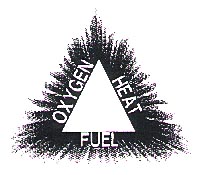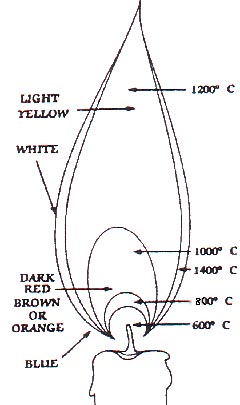Fire and Succession
Fires, both natural and human-caused are important events which interupt the
cycle of succession and create areas within the community which are at different
stages of succession.
In many cases, fires eliminate duff (old leaves and conifer needles), logs,
or branches which collect on the ground and could create a larger fire (one
that leap into the lower branches of trees) that would endanger the trees and
shrubs. In addition, fire recycles the nutrients and minerals in dead materials
back into fertilizer which can be used by young plants. In some cases, a fire
might remove old, diseased trees and shrubs, making the forest more healthy.
Some trees and shrubs need a fire to kill the older part of the plant so that
the roots can send new shoots into growth. These not only revitalize the community
with their growth, but also they provide food for many browsing animals. Finally,
many conifers need fire to open the cones and release the seeds to the fertilized
ground.
The Fire Triangle
 A fire needs 3 things to
start. These 3 things make up the fire triangle. The fire triangle consists
of the following 3 elements: fuel, heat, and oxygen. In order for a fuel to
burn it must reach a certain temperature (called the ignition point) in the
presence of oxygen.
A fire needs 3 things to
start. These 3 things make up the fire triangle. The fire triangle consists
of the following 3 elements: fuel, heat, and oxygen. In order for a fuel to
burn it must reach a certain temperature (called the ignition point) in the
presence of oxygen.
Fuel is what feeds the fire. Examples of fuel include gasoline, coal, wood,
and various types of vegetation such as trees, shrubs, and grasses.
Heat: In order for objects consisting of hydrogen and carbon to burn, heat
msut be intorduced. Heat is simply rapid molecular activity. It can be produced
with mechanical, electrical, chemical or nuclear energy.
Oxygen: Air is one-fifth oxygen. When heat is applied to a fuel in the presence
of oxygen, it makes the molecules in the fuel and air move faster. They collide
like autos and stick together, which causes them to react. If enough collisions
of fuel and oxygen molecules occur, then a fire results.
To stop a fire, one can remove the oxygen (smother it with a foamy extinguisher
or cover a small fire with a blanket) and the fire dies down quickly. One can
also reduce the heat (this is what happens when you stir the coals of a fire
and spread them far apart). Finally, one can remove the fuel. In the case of
forest fires, the fire fighters try to make a fire line that has had all fuel
(plants, wood, leaves, etc) which they hope will be wide enough to kill the
fire.
Characteristics of a Flame

The diagram at right shows a flame. The fuel and oxygen mix at the base of
the flame (oxygen always enters the fire at the base of the flames). The diagram
shows that the coolest part of the flame is at its base while the upper part
of the flame is the second hottest place in the flame. The actual combustion
takes place in a narrow bluish band that encircles the outside of the base of
the flame. This bluish zone is the combustion reaction zone, and it may reach
temperatures of about 1400 degrees Celsius (about 2700 degrees Fahrenheit).
The dark inner portion of the flame indicates "cooler" temperatures
and lack of oxygen.
Slichter
 A fire needs 3 things to
start. These 3 things make up the fire triangle. The fire triangle consists
of the following 3 elements: fuel, heat, and oxygen. In order for a fuel to
burn it must reach a certain temperature (called the ignition point) in the
presence of oxygen.
A fire needs 3 things to
start. These 3 things make up the fire triangle. The fire triangle consists
of the following 3 elements: fuel, heat, and oxygen. In order for a fuel to
burn it must reach a certain temperature (called the ignition point) in the
presence of oxygen.